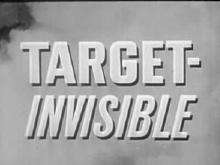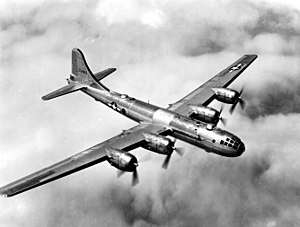Target-Invisible
Target-Invisible is a 1945 documentary short film produced by the First Motion Picture Unit after World War II. The film depicts the uses of radar in aerial direction-finding and precision high-level bombing by the United States Army Air Forces during World War II.
| Target-Invisible | |
|---|---|
 | |
| Starring |
|
| Narrated by | Arthur Kennedy |
Production company | |
| Distributed by | Motion Pictures and Special Events Division of the War Finance Division, U.S. Treasury Department |
Release date |
|
Running time | Eight minutes. 23 seconds |
| Country | United States |
| Language | English |
At the end of Target-Invisible, the air force narrator (Arthur Kennedy) thanks Americans for their contributions to the war effort but even though the war is over. The film mentions the dropping of the atom bomb in August 1945. The plea is for Americans to help win the peace by supporting scientific efforts through buying Victory Loan war bonds.[1]
Plot
In 1945, a USAAF Boeing B-29 Superfortress squadron of bombers flies from their base in the Marianas on their mission to attack a target in Japan. Although the target will be invisible due to overcast conditions, the mission will continue as a high-altitude bombing raid.
After six hours of flight time, the radar operator (Clayton Moore) is able to identify the islands that lie off the coast of Honshu. Directions from the radar operator to the bombardier help guide the B-29 to its ultimate target. The pilot is also given discrete flight adjustments to fly directly to the objective.
After arriving above the target at 23,000 ft altitude, although obscured by a thick cloud cover, the bombardier uses the Norden bombsight to aim, before releasing the bomb load. The attack is successful with widespread destruction of the Kiyoshi aircraft plant located north of Tokyo.
Cast
- Arthur Kennedy as Air force narrator (Uncredited)
- Clayton Moore as B-29 radar operator (Uncredited)

Production
Target-Invisible was produced for the Motion Pictures and Special Events Division of the War Finance Division, U.S. Treasury Department. The short has an orchestral score, and has a combination of live-action shot in the Culver City, California studios and stock combat footage of B-29s.[2]
Reception
Target-Invisible was typical of the training and recruitment films of the period produced under the auspices of the Office of War Information.[3]
See also
- List of Allied Propaganda Films of World War 2
References
Notes
- Moore and Thompson 1998, p. 71.
- "Overview: 'Target-Invisible'." IMDb. Retrieved: January 28, 2017.
- Koppes and Black 1987, p. 58.
Bibliography
- Koppes, Clayton R. and Gregory D. Black. Hollywood Goes to War: How Politics, Profits and Propaganda Shaped World War II Movies. New York, The Free Press, 1987. ISBN 0-02-903550-3.
- Moore, Clayton and Frank Thompson. I Was That Masked Man. New York: Taylor Trade Publishing;, 1998. ISBN 978-0-8783-3216-8.